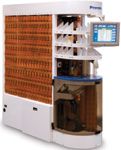Device vendors aim to limit cross-contamination
Debris, powder, loose pills, and broken capsules. The very real possibility of medication cross-contamination during automated pill counting is becoming an increasing safety concern. Manufacturers of the semi-automated and fully automated, or robotic, counting technology used in many retail and most hospital pharmacies say they consider cross-contamination a major issue. It's so important, in fact, that system design is used as a marketing tool in a highly competitive field.

Said Mary Reno, CEO of Innovation Associates in Johnson City, N.Y., manufacturer of PharmASSIST, "Our counting systems are designed to eliminate any possibility of contamination. That's a key marketing feature."

Michael Coughlin is president and CEO of ScriptPro, based in Mission, Kan. His SP series of robotic prescription dispensing systems does not use air pressure or a vacuum system to move pills, he pointed out. The system fills vials directly from the dispensing cells-two innovations that avoid cross-contamination. "Drugs are very powerful," he said. That's why we aggressively address the issue in our design phase."
Most manufacturers address the problem aggressively, said Wayne M. Caverly, president of Efficient Pharmacy Solutions, a consulting company. Now retired from McKesson Automated Prescription Systems, he is an expert on pharmacy design. "I know that a great deal of effort is spent on this issue among these companies," he said. "They recognize the importance of the issue to pharmacists and hospitals."
That's all to the good, said Luci Power, R.Ph., senior pharmacist and manager for parenteral support services at the University of California Medical Center in San Francisco. "The danger of cross-contamination has been an important issue for years, and I know that automated-dispensing manufacturers are aware of that," she said. "Anyone who opens a bottle of pills can see there is often residue at the bottom of the bottle. It should be an issue that is addressed in the design of any dispensing system." Some drugs, especially penicillin, sulfides, and oncology-related drugs, pose particularly significant threats, Power said. The threat from penicillin and sulfides is allergic reactions, and chemotherapy drugs are deadly.
The safety issue posed by such drugs is foremost, said Parata's Rhoads, and not just in relation to cross-contamination. Being certain that the correct drugs go into the correct holding cell is usually accomplished by bar-coding. And most manufacturers offer technology that labels the dispensing drug vials. "Putting the right pill in the right cell begins with bar-code technology," he said. "Our system makes certain the correct pill goes into the correct vial."
These safety concerns are all critical to the success of the industry. "Manufacturers should always be ready to go back to their drawing boards," said Ming Koh, a pharmacy technician from Seattle who has created a disposable tray and spatula to avoid the problem of cross-contamination. "There are always ways to improve the technology."
THE AUTHOR is a writer based in Gettysburg, Pa.